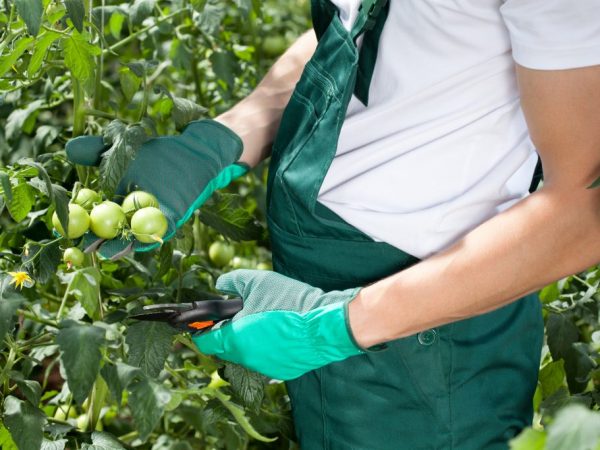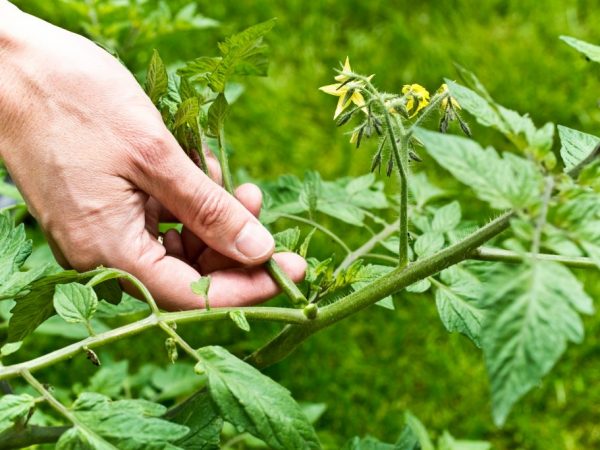Rules for pruning tomatoes in a greenhouse
When growing a tomato crop, the formation of a bush is of no small importance. Correctly carried out pruning of tomatoes in a greenhouse is the key to a future good harvest of vegetables.

Rules for pruning tomatoes in a greenhouse
Why trim
Tomatoes growing in greenhouses are pruned due to the limited confined space. In such conditions, the risk of the development and spread of diseases affecting tomatoes increases, and the care of tomato plantings becomes more difficult. Due to insufficient illumination, full-fledged photosynthesis is disrupted, which affects the quality of ripening fruits, and in the shade the emerging tomato ovaries begin to rot.
Correctly carried out pruning of tomatoes in a greenhouse will allow:
- accelerate the ripening of vegetables,
- to minimize the damage to plantings by infectious bacterial and fungal diseases,
- increase the yield of vegetable crops,
- provide proper care for tomato bushes.
Remembering the pruning of tomatoes only in the middle of the growing season, many summer residents decide on drastic measures, cutting off a large amount of foliage and shoots in a short period of time, which leads to stress in plants and causes their oppression.
Pruning steps
To properly prune tomatoes in a greenhouse, you need to know the basic shaping techniques, which include:
- pinching, or removing excess shoots on tomato bushes,
- removal of foliage,
- pinching the top of the plants, or punching.
How to make pinning
Grasshopping involves pruning off excess shoots that form in the leaf axil on the main shoot. Usually, this procedure begins after a couple of weeks from the moment the tomato seedlings are planted in the greenhouse, when the plants finally take root and start growing.
It is much easier to cut bushes at the initial stage of tomato growth: the plants are still low and you can clearly see which stepsons should be cut off and which ones should be left.
Tatiana Orlova (Candidate of Agricultural Sciences):
Removing stepchildren - pinching, is often carried out without the use of tools, just by hand. Therefore, the stepsons are not cut off, but neatly broken out. But there are also nuances here. Like all operations, pinching is done only with clean, well-washed hands. If among tomato plants there are suspicious for viral infections (they look somewhat depressed, the leaves began to "spin", the tip of the shoot is mosaic green), then such plants are pinched last so as not to transmit the virus on the hands of healthy plants.
Some tomato varieties do not require pinching. Be sure to carry out the procedure for tall varieties.
When a tomato bush is formed, 2-3 stems leave those lateral processes that are closest to the main stem. Subsequently, the first brushes will appear on them. The procedure is repeated at least 2 times a month so that the side stepchildren do not grow more than 7cm.It is recommended to prune the shoots in the morning using a garden tool, leaving a 3-4mm stump in place of pruning.
Some subtleties of pinching

Follow the recommendations
It is recommended to graze tomato plants taking into account their variety:
- Indeterminate varieties and hybrids form into 1 stem. For them, the first brush appears above the 10th or 11th leaf, the subsequent ones are left every three.
- In semi-indetas (80-100 cm high), a bush of 1-3 stems is formed. Otherwise, with a large number of central stems, the bush begins to overgrow with leaf mass, therefore it is recommended to give preference to the formation of 1 stem, cutting off the lateral processes. If you intend to leave the 2nd or 3rd additional stepchildren, they are formed under the first brush.
- Superdeterminate and determinant early varieties do not require pinching, but can be pinched to shape the plant as desired.
How to remove foliage
Removal of tomato foliage is carried out throughout the entire growing season of plant growth and development. They begin to prune the plant from the lower tier of leaves, when the first ovaries appear on the brushes, and the process ends by the end of the gardening season, when they start topping.
Timely pruning of the foliage of tomatoes allows you to open the formed ovaries for sunlight and air flow.
In order to avoid pulling off mineral nutrition by the green mass, it is recommended to cut the foliage once every 7 days, removing 2-3 leaves. In addition to the lower leaf layer, the leaves growing in the middle part of the tomato bush and almost not participating in photosynthesis are also removed. Both yellowed and diseased foliage should be trimmed.
Tatiana Orlova (Candidate of Agricultural Sciences):
Removing the leaves often performs another task - it prevents the plants from contacting the soil on which the infectious agent may be located. This operation is especially important in late July - early August, when the likelihood of the appearance of late blight of tomatoes increases.
How to perform edging
The pinching of the crown of tomato bushes begins to be carried out closer to the last days of July - at the beginning of August. The specific timing of the edging depends on the regional characteristics.
Under favorable warm climatic conditions, 2-3 tomato bushes are left, without cutting off their tops and without removing the newly appeared ovaries.
The main task of verchkovaya is to stop the growth of tomato bushes and preserve the strength of plants for ripening vegetables. Scaling also involves removing the flowers and small fruits growing at the top.
Tatiana Orlova (Candidate of Agricultural Sciences):
They also carry out vershoking for the reason that the height of the cultivation room (greenhouse) is lower than the height of the indeterminate tomato bushes. Condensation usually collects on the top of the greenhouse and contact of tomato leaves with a constantly wet glass or film surface leads to their disease and death.
Conclusion
When cultivating tomatoes, it is important to prune the tomatoes in the greenhouse in a timely manner. Correctly carried out the main stages of this procedure - pinching, removing excess foliage and punching - will ensure the full development of plants and make it possible for the fruits to ripen on time.



